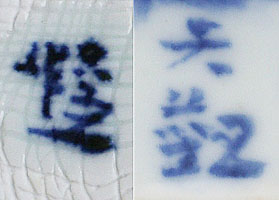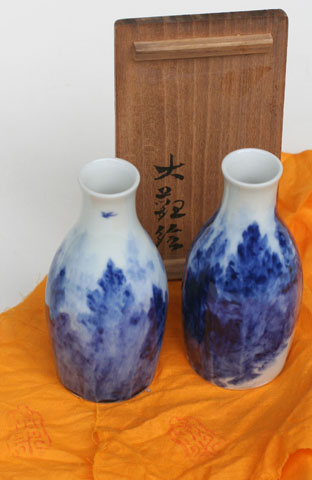Kyôyaki
Shubin (Tokkuri), set of sake bottles - Sammyaku, mountain rangeSigned: Taikan, Rokubei saku
Seals:
Technique: Kyôyaki sometsuke (Seikaji) - Translucent blue and white porcelain with a hand painted cobalt blue underglaze decoration. Ø 4,6 x 11,8
Date: c. 1928
Box: signed by Rokubei; chakin sealed
Condition: fine
Nr. 107 at Taikan Yokoyama Retrospective at the Utsunomiya Museum of Art (16/09 -14/10 - 2012)
Comparable with nr. 38, a bamboo decorated set at Taikan Kinenkan, Tokyo 1993
Taikan was born in Mito city, Ibaraki Prefecture, as the eldest son of Sakai Sutehiko, an ex-samurai family in Mito clan. He was adopted into his mother's family, from whom he received the name of "Yokoyama". With his family, he moved to Tokyo in 1878. He studied at the Tōkyō Furitsu Daiichi Chūgakkō (Hibiya High School), and was interested in the English language and in western style oil painting. This led him to study pencil drawing with a painter, Watanabe Fumisaburo. He also studied at one of the great painters, Kanō Hōgai, who was the master of Kanō school.
In 1889, Taikan enrolled in the first graduating class of the Tōkyō Bijutsu Gakkō (the predecessor to the Tokyo National University of Fine Arts and Music), which had just been opened by Okakura Kakuzō (aka Okakura Tenshin). In 1913 Taikan, assisted by Yasuda Yukihiko (1884-1978), concentrated on reviving the Japan Fine Arts Academy, which had closed down upon Okakura Kakuzō's death.
Taikan was extremely influential in the evolution of the Nihonga technique, having departed from the traditional method of line drawing. Together with Hishida Shunsō, he developed a new style, Mourou-tai, eliminating the lines and concentrating on soft, blurred polychromes. A number of his works have been classified as Important Cultural Property by the Agency for Cultural Affairs.
Reference:
https://en.wikipedia.org/wiki/Yokoyama_Taikan
and a large number of monographs
Rokubei V (Shôrei) (1875-1959) was the second son of Kiyomizu Rokubei IV.
Rokubei V studied Shijô painting with Kôno Bairei (1844-1895). Kikuchi Hôbun (1862-1918), Taniguchi Kôkyô (1864-1915), Takeuchi Seihô (1864-1942) and Tsuji Kakô (1870-1931) were his classmates. He also studied at the Kyoto Prefectural School of Painting, and studied ceramic techniques with his father after graduation. His career as a ceramic artist began when he won a prize at the Fourth Domestic Industrial Exposition in 1895. He studied glazing techniques at the Kyoto Municipal Ceramic Laboratory established in 1896 and organized the Promoting Society for Craft Workers (Shokkô Shôrei-kai) with designer Kikuchi Sokû at the Laboratory in 1899. He actively worked on the study and research of new glazing techniques and (Western) designs. When Rokubei IV retired, he inherited the title and became Rokubei V in 1913. He exhibited at the Nôten, the Design and Applied Artworks Exhibition sponsored by the Ministry of Agriculture and Commerce and the Teiten, the Imperial Art Academy Exhibition. He also became a member of the Imperial Art Academy and played an important role as a leading figure of the craft world. In 1945 he retired and took the artist’s name Rokuwa.
Reference:
Kyoto ‘03, ’Sekka’ p. 326 ff.
Price: ON REQUEST

